Thoroughly analyzing AP Inter 2nd Year Maths 2A Model Papers and AP Inter 2nd Year Maths 2A Question Paper March 2016 helps students identify their strengths and weaknesses.
AP Inter 2nd Year Maths 2A Question Paper March 2016
Time: 3 Hours
Maximum Marks: 75
Note: This question paper consists of three Sections A, B, and C.
Section – A
(10 × 2 = 20 Marks)
I. Very Short Answer Type Questions.
- Attempt all questions.
- Each question carries two marks.
Question 1.
If the Arg (\(\bar{z}_1\)) and Arg (z2) are \(\frac{\pi}{5}\) and \(\frac{\pi}{3}\) respectively, then find (Arg z1 + Arg z2).
Solution:
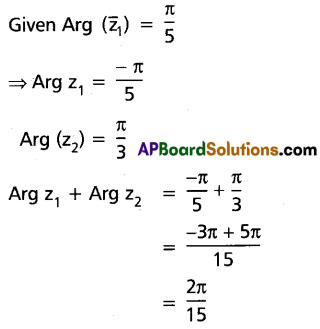
Question 2.
If (√3 + i)100 = 299 (a + ib), then show that a2 + b2 = 4.
Solution:

⇒ 2\(\left[\frac{-1}{2}+i \frac{\sqrt{3}}{2}\right]\) = a + ib
⇒ -1 + i√3 = a + ib
⇒ a = -1, b = √3
∴ a2 + b2 = 1 + 3 = 4
![]()
Question 3.
If A, B, and C are angles of a triangle such that x = cos A, y = cos B, z = cos C, then find the value of xyz.
Solution:
Since A, B, C are angles of a triangle.
∴ A + B + C = 180°
Given x = cos A, y = cos B, z = cos C
xyz = (cos A) (cos B) (cos C)
= cos (A + B + C)
= cos (180°)
= cos 180° + i sin 180°
= -1 + i(0)
= -1
∴ xyz = -1
Question 4.
If α, β are the roots of the equation ax2 + bx + c = 0, then find the value of \(\frac{1}{\alpha^2}+\frac{1}{\beta^2}\) in terms of a, b, c.
Solution:
Given α, β are the roots of the equation ax2 + bx + c = 0
∴ α + β = \(\frac{-b}{a}\) and αβ = \(\frac{c}{a}\)
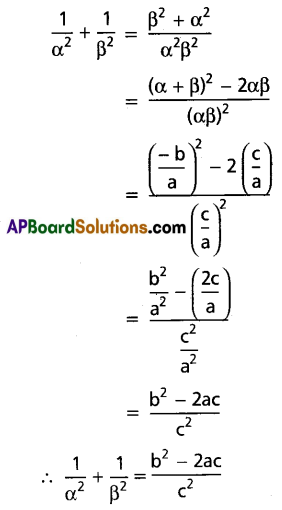
Question 5.
If α, β, and 1 are roots of x3 – 2x2 – 5x + 6 = 0, then find α and β.
Solution:
Given α, β, and 1 are the roots of x3 – 2x2 – 5x + 6 = 0
… α + β + 1 = \(\frac{-(-2)}{1}\) = 2
∴ α + β = 1 …….(1)
α.β.1 = \(\frac{-6}{1}\)
⇒ αβ = -6
(α – β)2 = (α + β)2 – 4αβ
= 1 – 4(-6)
= 1 + 24
= 25
∴ α – β = 5 ………(2)
(1) + (2) ⇒ 2α = 6 ⇒ α = 3
(1) – (2) ⇒ 2β = -4 ⇒ β = -2
∴ α = 3 and β = -2
Question 6.
If nPr = 5040 and nCr = 210, then find n and r.
Solution:
Given nPr = 5040 and nCr = 210
\(\frac{{ }^n P_r}{{ }^n C_r}=\frac{5040}{210}\)
⇒ r! = 24
⇒ r! = 4!
⇒ r = 4
∴ nPr = 5040
⇒ n(n – 1)(n – 2)(n – 3) = 10 × 9 × 8 × 7
⇒ n = 10
Question 7.
Find the number of positive divisors of 1080.
Solution:
1080 = 2 × 540
= 22 × 270
= 22 × 135
= 23 × 3 × 45
= 23 × 32 × 15
= 23 × 33 × 51
The number of positive divisors of 1080 = (3 + 1) (3 + 1) (1 + 1)
= 4 × 4 × 2
= 32
![]()
Question 8.
If 22Cr is the largest binomial coefficient in the expansion of (1 + x)22, find the value of 13Cr.
Solution:
Here n = 22 (even integer)
∴ The largest binomial co-efficient = \({ }^n C_{\left(\frac{n}{2}\right)}\) = 22C11
∴ r = 11
13Cr = 13C11
= 13C2
= \(\frac{13.12}{2}\)
= 78
∴ 13Cr = 13C11 = 78
Question 9.
Find the mean deviation about the median for the following data:
13, 17, 16, 11, 13, 10, 16, 11, 18, 12, 17
Solution:
Given data points are 13, 17, 16, 11, 13, 10, 16, 11, 18, 12, 17
Now arrange those data points in ascending order
10, 11, 11, 12, 13, 13, 16, 16, 17, 17, 18
∴ Median = 13
Absolute values = |13 – 10|, |13 – 11|, |13 – 11|, |13 – 12|, |13 – 13|, |13 – 16|, |13 – 16|, |13 – 17|, |13 – 17|, |13 – 18| = 3, 2, 2, 1, 0, 0, 3, 3, 4, 5
Mean deviation about the median = \(\frac{3+2+2+1+0+0+3+3+4+5}{11}\)
= \(\frac{27}{11}\)
= 2.45
Question 10.
The mean and variance of a binomial distribution are 4 and 3 respectively. Fix the distribution and find P(X ≥ 1).
Solution:
Let X follow a binomial distribution with parameters n and p.
Mean np = 4 and variance npq = 3
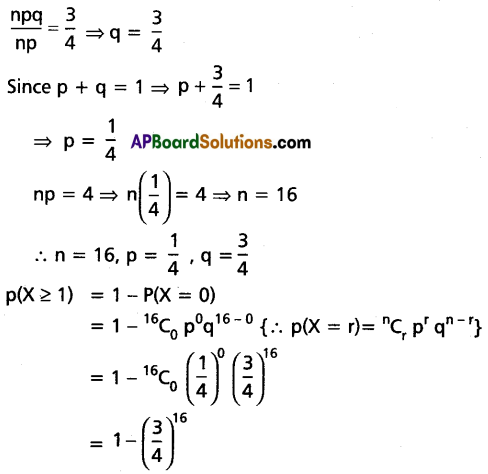
Section – B
(5 × 4 = 20 Marks)
II. Short Answer Type Questions.
- Attempt any five questions.
- Each question carries four marks.
Question 11.
If x + iy = \(\frac{1}{1+\cos \theta+i \sin \theta}\), then show that 4x2 – 1 = 0.
Solution:
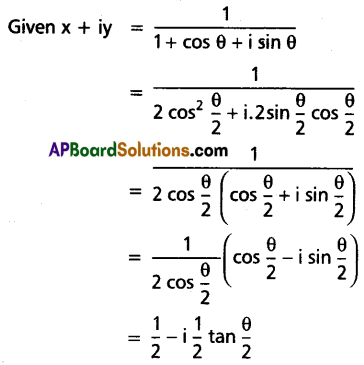
Now, equating real parts on both sides, we have
x = \(\frac{1}{2}\)
⇒ x2 = \(\frac{1}{4}\)
⇒ 4x2 = 1
⇒ 4x2 – 1 = 0
Question 12.
Prove that \(\frac{1}{3 x+1}+\frac{1}{x+1}-\frac{1}{(3 x+1)(x+1)}\) does not lie between 1 and 4, if x is real.
Solution:
Let y = \(\frac{1}{3 x+1}+\frac{1}{x+1}-\frac{1}{(3 x+1)(x+1)}\)
= \(\frac{x+1+3 x+1-1}{(3 x+1)(x+1)}\)
= \(\frac{4 x+1}{3 x^2+3 x+x+1}\)
= \(\frac{4 x+1}{3 x^2+4 x+1}\)
⇒ 3yx2 + 4yx + 4 = 4x + 1
⇒ 3yx2 + (4y – 4)x + (y – 1) = 0
x ∈ R ⇒ (4y – 4)2 – 4(3y)(y – 1) ≥ 0
⇒ 16y2 – 32y + 16 – 12y2 + 12y ≥ 0
⇒ 4y2 – 20y + 16 ≥ 0
⇒ y2 – 5y – 4 ≥ 0
⇒ (y – 1) (y – 4) ≥ 0
⇒ y ≥ 0 (or) y ≥ 4
∴ \(\frac{1}{3 x+1}+\frac{1}{x+1}-\frac{1}{(3 x+1)(x+1)}\) does not lie between 1 and 4.
![]()
Question 13.
If the letters of the word EAMCET are permuted in all possible ways and if the words thus formed are arranged in the dictionary order, find the rank of the word EAMCET.
Solution:
The dictionary order of the letters of the word EAMCET is A, C, E, E, M, T
In dictionary order, the words which begin with the letter A come first.
If we fill the first place with A remaining 5 letters can be arranged in \(\frac{5 !}{2 !}\) ways.
A – – – – – = \(\frac{5 !}{2 !}=\frac{120}{2}\) = 60
C – – – – – = \(\frac{5 !}{2 !}=\frac{120}{2}\) = 60
E A C – – – = 3! = 6
E A E – – – = 3! = 6
The next word is EAMCET = 1
Hence the rank of the word EAMCET is 60 + 60 + 6 + 6 + 1 = 133
Question 14.
Simplify: \({ }^{34} C_5+\sum_{r=0}^4{ }^{38-r} C_4\)
Solution:
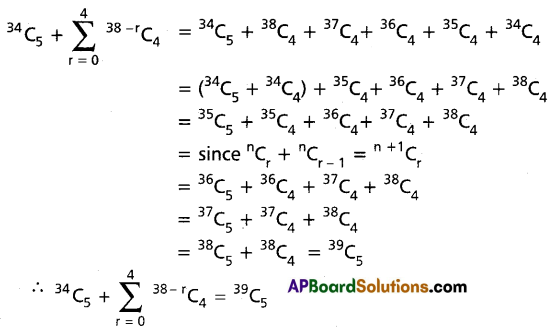
Question 15.
Resolve \(\frac{x^2-3}{(x+2)\left(x^2+1\right)}\) into partial fractions.
Solution:
Let \(\frac{x^2-3}{(x+2)\left(x^2+1\right)}=\frac{A}{x+2}+\frac{B x+C}{x^2+1}\)
⇒ \(\frac{x^2-3}{(x+2)\left(x^2+1\right)}=\frac{A\left(x^2+1\right)+(B x+C)(x+2)}{(x+2)\left(x^2+1\right)}\)
⇒ x2 – 3 = A(x2 + 1) + (Bx + C) (x + 2) ……….(1)
Put x = -2 in (1)
(-2)2 – 3 = A[(-2)2 + 1]
⇒ 4 – 3 = A(4 + 1)
⇒ 1 = 5A
⇒ A = \(\frac{1}{5}\)
Comparing the coefficients of x2 and constant terms in (1), we get
1 = A + B
⇒ 1 = \(\frac{1}{5}\) + B
⇒ B = 1 – \(\frac{1}{5}\)
⇒ B = \(\frac{4}{5}\)
∴ -3 = A + 2C
⇒ 2C = -3 – A
⇒ 2C = -3 – \(\frac{1}{5}\)
⇒ 2C = \(\frac{-16}{5}\)
⇒ C = \(\frac{-8}{5}\)
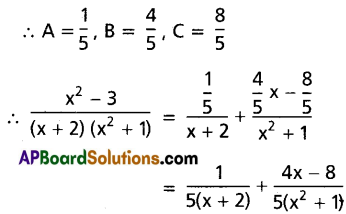
Question 16.
The probability for a contractor to get a road contract is \(\frac{2}{3}\) and to get a building contract is \(\frac{5}{9}\). The probability to get at least one contract is \(\frac{4}{5}\). Find the probability that he gets both contracts.
Solution:
Let A be the event of getting a road contract and B be the event of getting a building contract.
∴ P(A) = \(\frac{2}{3}\), P(B) = \(\frac{5}{9}\) and P(A ∪ B) = \(\frac{4}{5}\)
By addition theorem on probability, we have
P(A ∪ B) = P(A) + P(B) – P(A ∩ B)
⇒ P(A ∩ B) = P(A) + P(B) – P(A ∪ B)
= \(\frac{2}{3}+\frac{5}{9}-\frac{4}{5}\)
= \(\frac{30+25-36}{45}\)
= \(\frac{19}{45}\)
∴ The probability to get both the contracts = \(\frac{19}{45}\)
Question 17.
A speaks truth in 75% of the cases and B in 80%. What is the probability that their statements about an incident do not match?
Solution:
Let E1 and E2 be the events that A and B respectively speak the truth about an incident.
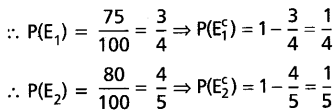
If E is the event that their statements do not match about the incident, then this happens in two mutually exclusive ways.
(i) A speaks the truth and B tells a lie.
(ii) A tells a lie and B speaks the truth.
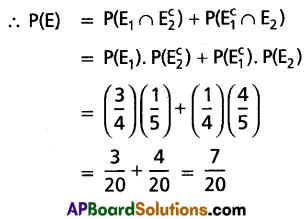
Section – C
(5 × 7 = 35 Marks)
III. Long Answer Type Questions.
- Attempt any five questions.
- Each question carries seven marks.
Question 18.
If cos α + cos β + cos γ = 0 = sin α + sin β + sin γ, then prove that cos2α + cos2β + cos2γ = \(\frac{3}{2}\) = sin2α + sin2β + sin2γ.
Solution:
Let a = cos α + i sin α
b = cos β + i sin β
c = cos γ + i sin γ
a + b + c = (cos α + i sin α) + (cos β + i sin β) + (cos γ + i sin γ)
= (cos α + cos β + cos γ) + i(sin α + sin β + sin γ)
= 0 + i(0)
= 0
⇒ a + b + c = 0
\(\frac{1}{a}+\frac{1}{b}+\frac{1}{c}=\frac{1}{\cos \alpha+i \sin \alpha}+\frac{1}{\cos \beta+i \sin \beta}+\frac{1}{\cos \gamma+i \sin \gamma}\)
\(\frac{b c+c a+a b}{a b c}\) = cos α – i sin α + cos β – i sin β + cos γ – i sin γ
= (cos α + cos β + cos γ) + i (sin α + sin β + sin γ)
= 0 – i(0)
= 0
⇒ ab + bc + ca = 0
(a + b + c)2 = a2 + b2 + c2 + 2(ab + bc + ca)
⇒ 0 = a2 + b2 + c2 + 2(0)
⇒ a2 + b2 + c2 = 0
⇒ (cos α + i sin α)2 + (cos β + i sin β)2 + (cos γ + i sin γ)2 = 0
⇒ cos 2α + i sin 2α + cos 2β + i sin 2β + cos 2γ + i sin 2γ = 0
⇒ (cos 2α + cos 2β + cos 2γ) + i(sin 2α + cos 2β + sin 2γ) = 0
Equating real parts on both sides, we have
cos 2α + cos 2β + cos 2γ = 0
⇒ 1 – 2 sin2α + 1 – 2 sin2β + 1 – 2 sin2γ = 0
⇒ 3 = 2(sin2α + sin2β + sin2γ)
⇒ sin2α + sin2β + sin2γ = \(\frac{3}{2}\)
Again cos 2α + cos 2β + cos 2γ = 0
⇒ 2 cos2α – 1 + 2 cos2β – 1 + 2 cos2γ – 1 = 0
⇒ 2(cos2α + cos2β + cos2γ) = 3
⇒ cos2α + cos2β + cos2γ = \(\frac{3}{2}\)
∴ cos2α + cos2β + cos2γ = \(\frac{3}{2}\) = sin2α + sin2β + sin2γ
![]()
Question 19.
Solve the equation 2x5 + x4 – 12x3 – 12x2 + x + 2 = 0.
Solution:
Given 2x5 + x4 – 12x3 – 12x2 + x + 2 = 0
This is an add-degree reciprocal equation of the first type.
∴ -1 is a root.

∴ (x + 1) is a factor of the given equation.
2x4 – x3 – 11x2 – x + 2 = 0
∴ 2x2 – x – 11 – \(\frac{1}{x}+\frac{2}{x^2}\) = 0
⇒ \(2\left(x^2+\frac{1}{x^2}\right)-\left(x+\frac{1}{x}\right)\) – 11 = 0
Let x + \(\frac{1}{x}\) = t, Then x2 + \(\frac{1}{x^2}\) = t2 – 2
∴ 2(t2 – 2) – t – 11 = 0
⇒ 2t2 – 4 – t – 11 = 0
⇒ 2t2 – t – 15 = 0
⇒ 2t2 – 6t + 5t – 15 = 0
⇒ 2t(t – 3) + 5(t – 3) = 0
⇒ (t – 3) + (2t + 5) = 0
⇒ t = 3 (or) \(\frac{-5}{2}\)
When t = 3
⇒ x + \(\frac{1}{x}\) = 3
⇒ x2 + 1 = 3x
⇒ x2 – 3x + 1 = 0
⇒ x = \(\frac{3 \pm \sqrt{9-4.1 .1}}{2}\)
⇒ x = \(\frac{3 \pm \sqrt{9-5}}{2}\)
⇒ x = \(\frac{3 \pm \sqrt{5}}{2}\)
When t = \(\frac{-5}{2}\)
⇒ x + \(\frac{1}{x}\) = \(\frac{-5}{2}\)
⇒ 2x2 + 2 = -5x
⇒ 2x2 + 5x + 2 = 0
⇒ 2x2 + 4x + x + 2 = 0
⇒ 2x(x + 2) + (x + 2) = 0
⇒ (x + 2) + (2x + 1) = 0
⇒ x = -2, \(\frac{-1}{2}\)
∴ The roots of the given equation are -1, \(\frac{3 \pm \sqrt{5}}{2}\), -2, \(\frac{-1}{2}\)
Question 20.
If P and Q are the sum of odd terms and the sum of even terms respectively, in the expansion of (x + a)n then prove that
(i) P2 – Q2 = (x2 – a2)n
(ii) 4PQ = (x + a)2n – (x – a)2n
Solution:


(i) P2 – Q2 = (P + Q) (P – Q)
= (x + a)n . (x – a)n
= [(x + a) . (x – a)]n
= (x2 – a2)n
∴ P2 – Q2 = (x2 – a2)n
(ii) 4PQ = (P + Q)2 (P – Q)2
= [(x + a)n]2 – [(x – a)n]2
= (x + a)2n . (x – a)2n
= (x2 – a2)2n
= (x + a)2n – (x – a)2n
∴ 4PQ = (x + a)2n – (x – a)2n
Question 21.
Find the sum to infinite terms of the series \(\frac{7}{5}\left(1+\frac{1}{10^2}+\frac{1.3}{1.2} \cdot \frac{1}{10^4}+\frac{1.3 .5}{1.2 .3} \cdot \frac{1}{10^6}+\ldots .\right)\)
Solution:
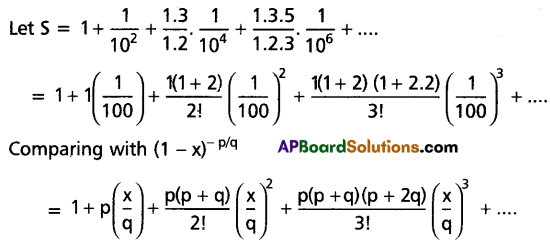
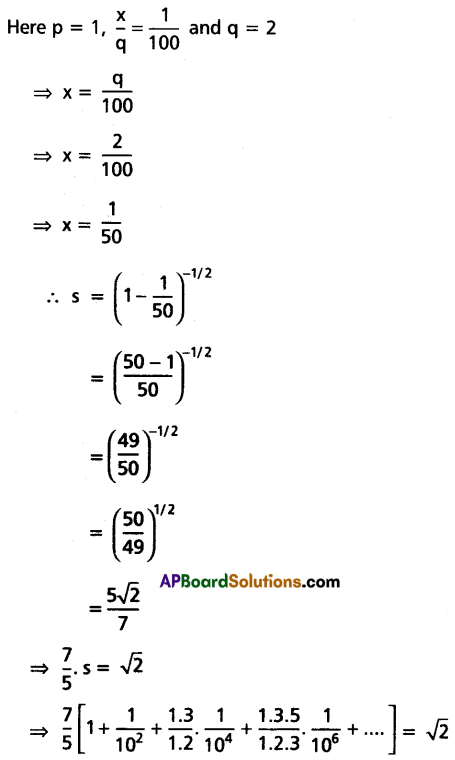
Question 22.
Find the mean deviation about the mean for the following data.
| Marks Obtained | 0-10 | 10-20 | 20-30 | 30-40 | 40-50 |
| Number of Students | 5 | 8 | 15 | 16 | 6 |
Solution:
Taking the assumed mean a = 25 and h = 10
Construct the table

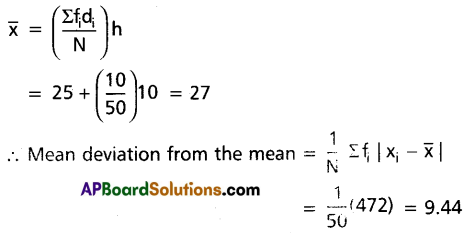
Question 23.
Three boxes numbered I, II, and III contain the balls as follows.
| White | Black | Red | |
| I | 1 | 2 | 3 |
| II | 2 | 1 | 1 |
| III | 4 | 5 | 3 |
One box is randomly selected and a ball is drawn from it. If the ball is red, then find the probability that it is from box II.
Solution:
Let B1, B2, and B3 be the events of selecting I, II, and III boxes respectively.
∴ P(B1) = P(B2) = P(B3) = \(\frac{1}{3}\)
\(P\left(\frac{R}{B_1}\right)\) = Probability of selecting a red ball shown the first box = \(\frac{3}{6}\)
\(P\left(\frac{R}{B_2}\right)\) = Probability of selecting a red ball from the second box = \(\frac{1}{4}\)
\(P\left(\frac{R}{B_3}\right)\) = Probability of selecting a red ball from the third box = \(\frac{3}{12}\)
Assuming that the ball is red, the probability it is from box II.
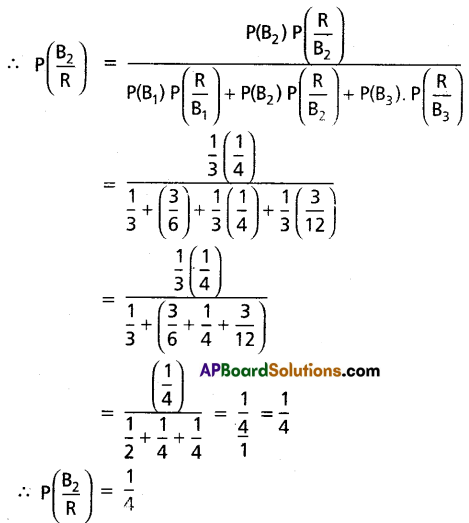
![]()
Question 24.
A random variable X has the following probability distribution.
| X = x | 0 | 1 | 2 | 3 | 4 | 5 | 6 | 7 |
| P(X = x) | 0 | k | 2k | 2k | 3k | k2 | 2k2 | 7k2 + k |
Find: (i) k (ii) The mean and (iii) P(0 < X < 5).
Solution:
We know ΣP(X = x) = 1
⇒ 0 + k + 2k + 2k + 3k + k2 + 2k2 + 7k2 + k = 1
⇒ 10k2 + 9k = 1
⇒ 10k2 + 9k – 1 = 0
⇒ 10k2 + 10k – k – 1 = 0
⇒ 10k(k + 1) – 1(k + 1) = 0
⇒ (10k – 1) (k + 1) = 0
⇒ k = \(\frac{1}{10}\), -1
(i) k = \(\frac{1}{10}\) Since k > 0
(ii) Mean = 0 P(X = 0) + 1 P(X = 1) + 2 P(X = 2) + 3 P(X = 3) + 4 P(X = 4) + 5 P(X = 5) + 6 P(X = 6) + 7 P(X = 7)
= 0(0) + 1(k) + 2(2k) + 3(2k) + 4(3k) + 5(k2) + 6(2k2) + 7(7k2 + k)
= 0 + k + 4k + 6k + 12k + 5k2 + 12k2 + 49k2 + 7k
= 66k2 + 30k
= 66(\(\frac{1}{100}\)) + 30(\(\frac{1}{10}\))
= 0.66 + 3
= 3.66
(iii) P(0 < x < 5) = P(X = 1) + P(X = 2) + P(X = 3) + P(X = 4)
= k + 2k + 2k + 3k
= 8k
= 8(\(\frac{1}{10}\))
= 0.8